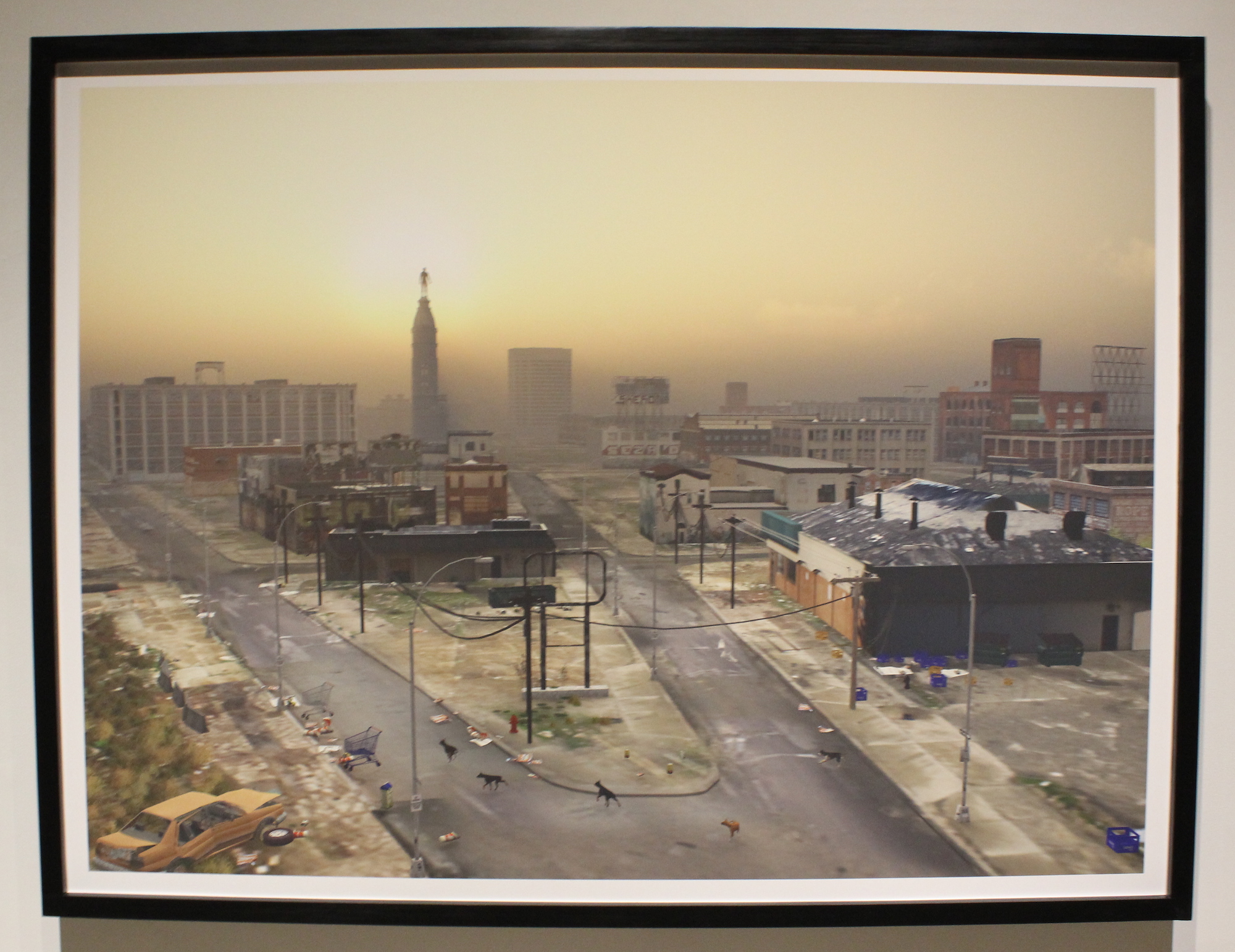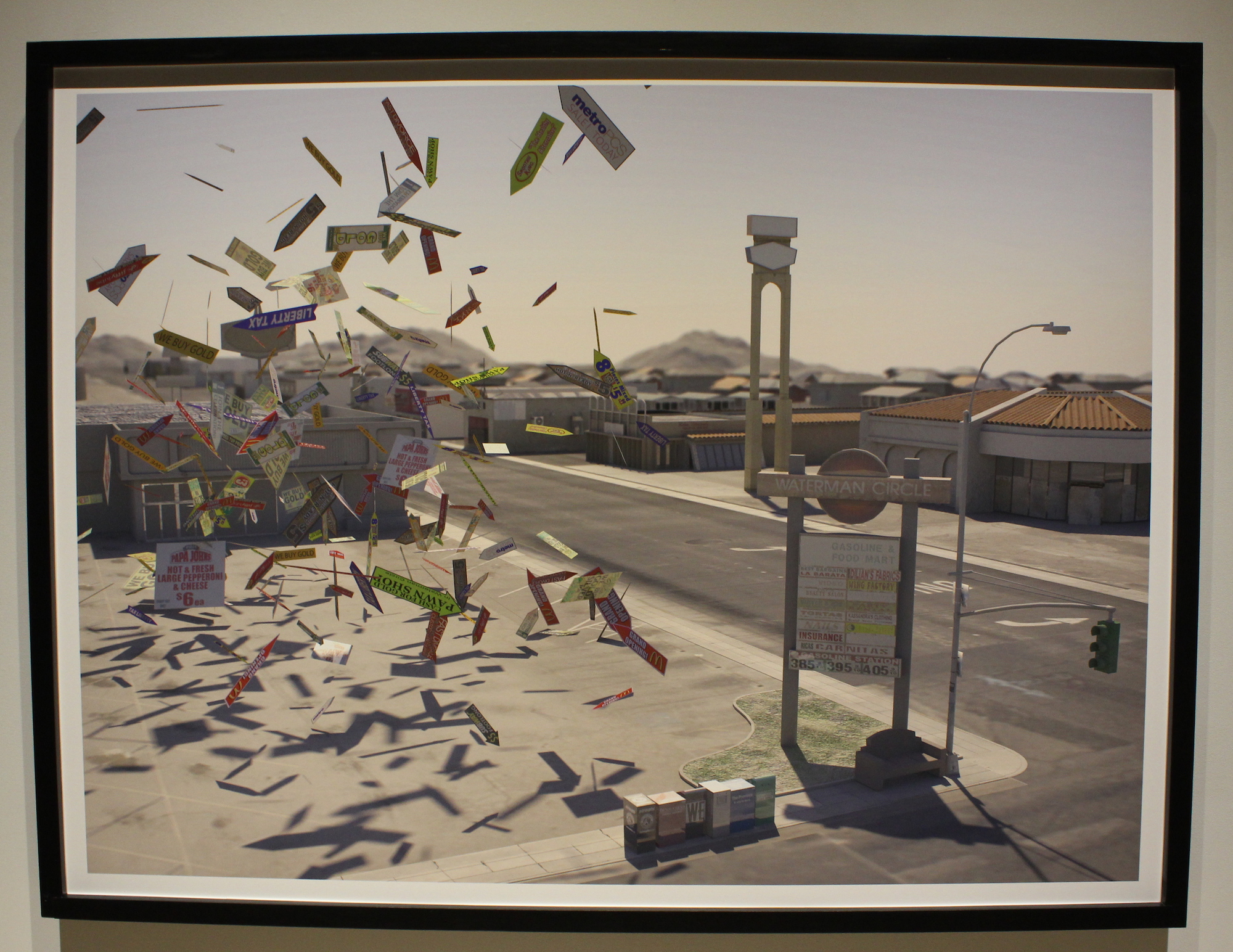
Tim Portlock beckons us to enter a world we will never see at Locks Gallery in Philadelphia
Above: Tim Portlock, “Night.” Photos by Chip Schwartz.
In Tim Portlock‘s world, it’s easy to encounter a remarkable sense of familiarity. In many ways, the locations he presents are just like places we’ve been. The thing is, in light of this recognition of place, there is not a face to be seen. The streets are utterly devoid of people, although their presence is unmistakable: signs, buildings, parking lots and graffiti populate the landscape, and yet, the most integral part of the city–its inhabitants–remain only as an echo. Portlock’s first exhibition at Philadelphia’s Locks Gallery, titled “Ash and Gold,” is a solo show of both great magnitude and complete emptiness, a testament to both the excess and the alienation of our time.
Every one of these images is digitally rendered using a combination of photographic documentation, 3-D animation and digital effects in order to construct semi-fictional cityscapes that seem to challenge our impressions at every corner. In their sparseness lies a complexity and attention to detail that calls to mind Portlock’s many paradoxes, which are programmed into his portrayals of contemporary urban existence.
Straddling North America from coast to coast, Portlock’s subjects are representations of either Philadelphia or San Bernardino, Calif. Brightly lit streets, green palm fronds and parking lots clearly indicate the Southern California scenes, while gigantic concrete warehouses, shopping carts, abandoned cars and billboards embody Philadelphia.

Tim Portlock, “Salon.”
While the architecture and scenery of these places makes their real life counterparts relatively easy to discern, it is worth noting that Portlock is heavily invested in his hyperbole, especially when it comes to Philadelphia. Although a billboard depicting blue skies and the very same palm trees that stand tall around it is quizzical, the atmosphere of Philly appears downright catastrophic. In most of these renditions of the metropolitan Northeast, orange haze and general ruin are the law of the land, to the extent that these virtual war zones have any laws.
Philadelphia is, of course, not a post-apocalyptic wasteland, despite what some Philadelphians might have you believe. The trash in the streets and the shoes dangling from the power lines in pieces like “Salon” emerge from a very real place, but the barely shining sun and barren hills seem more representative of 1999’s “The Matrix.” A variant of Philadelphia’s City Hall tower is visible in a number of pieces, but upon closer inspection, it is not William Penn atop the structure but a (seemingly) nude, bald silhouette that stands in as a generic avatar of true history. Like much in Portlock’s work, the recognizable is stripped down to the least amount of information necessary for understanding what we perceive.

Tim Portlock, “Desert Rain.”
In San Bernardino, on the other hand, the overall mood initially seems considerably less bleak. The video game terrain looks hot and dry, but there is very little overt destruction–no mangled row houses or toppling telephone poles. What these images lack in dystopian themes, however, they make up for in occasional splashes of humor or unbridled absurdity. Most notably in “Desert Rain,” the sky lets loose with its infrequent deluge, not of water, but of advertising. Dozens of signs pitching everything from pizza to pawn shops, tax services, cell phones and cash for gold drop clumsily out of the air into a strip mall abyss. This marketing falls not on deaf ears, but on no ears whatsoever.

Tim Portlock, “Memorial.”
Elsewhere, in “Memorial,” a makeshift assembly of candles, balloons and flowers marks the site of some anonymous tragedy behind a graffiti-covered wall adorned with clothing donation bins and mounds of garbage bags. In the sprawling urban environment, anonymity is not only a weight carried by the memorialized, but by a great many of us; these days it’s uncommon to become close with our neighbors, let alone a stranger on the street. These still-inflated balloons and trash that will never get picked up indicate that the populace vanished in a hurry, and aside from our omniscient vantage point, it seems like the fruits of all their labors will remain indefinitely, for no one at all.
Portlock’s vision is as much a reflection as it is a prophecy. It is bleak, but not without its scathing wit. As landscapes or video games, these places make for endless imaginative fodder or endless playgrounds, but seen as a warning of climate change or a call to better connect with our surroundings and our fellow creatures, it is intensely sober. Ultimately though, it is a farce. Tim Portlock’s planet is a place none of us could ever see, if for no other reason than we wouldn’t be around to see it. It is a science fiction novel fetishizing the end of humanity for human beings fed up with a malfunctioning system. After all, if a cash for gold sign falls in the desert, and no one is around to see it, can they still make a quick buck? “Ash and Gold” will be on display through July 15.
Recent Content
-
Artsarticle ·
-
Artsarticle ·
-
Artsarticle ·

